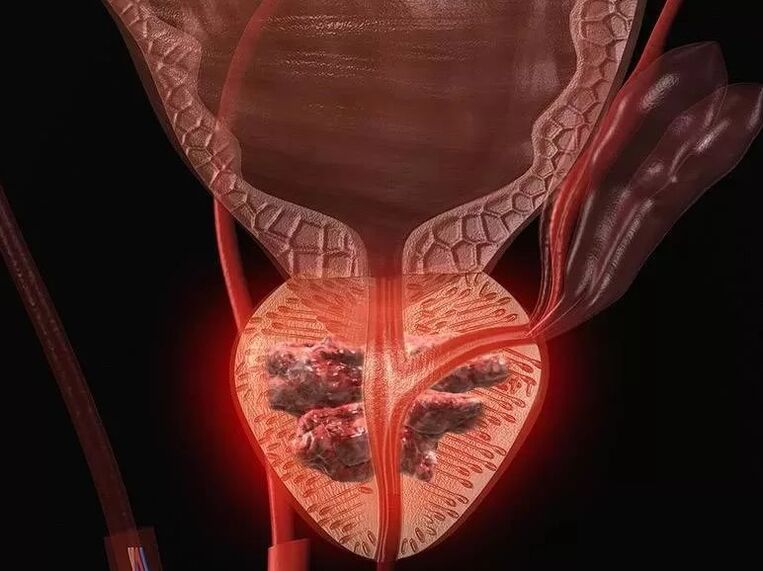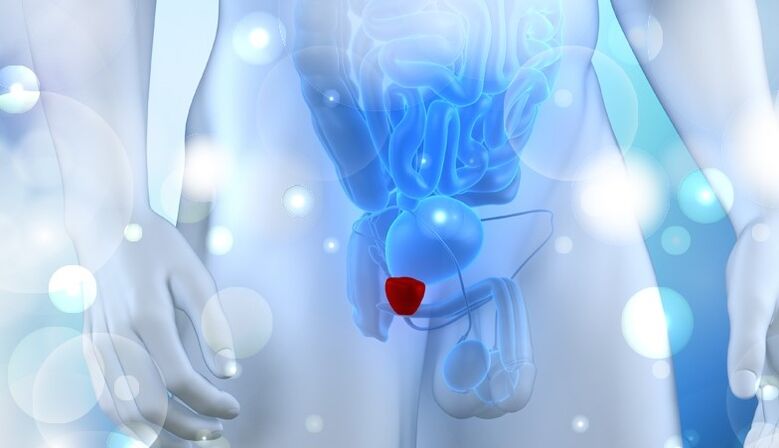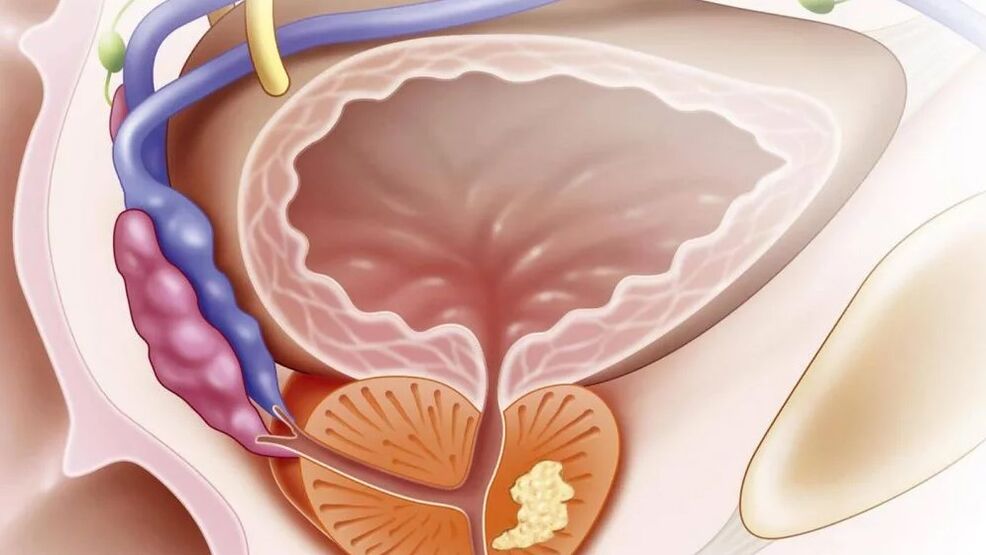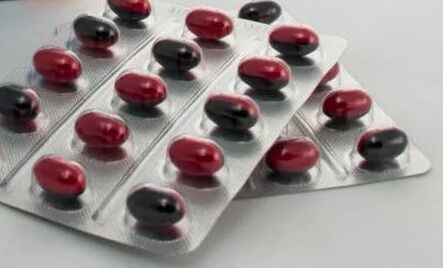One of the most dangerous complications of acute prostatitis can be the prostate gland. This is a focus, confusing inflammation where body temperature can rise to 40 degrees. Signs of abscess are acute intense pain and heavy urination. In the absence of medical care, swelling of the glandular tissue develops and the urethra lumen is completely blocked.
Prostatitis is the most common urological pathology in men of reproductive age. According to polls, at least once in his life, he has experienced third symptoms that can be interpreted as inflammation of the prostate gland. The main cause of bacterial prostatitis is infection, but only in acute prostatitis, the infection leads to sharp inflammation of the prostate gland, which is explained by the anatomical characteristics of the male body structure.
In the chronic form of prostatitis, the infection may also be caused by inflammatory mechanism, but the inflammation of the prostate mire, which requires treatment, can only be due to other factors:
- Long -term hypothermia, of different nature: it can sit in the ice hole or on cold stones, etc. ;
- a sedentary lifestyle that leads to stagnation of blood, which can cause inflammation;
- Irregular sex life: this refers to both excessive abstinence and excessive activity;
- Transaired Urological (such as urethritis) or sexually transmitted disease (gonorrhoea, chlamydia, etc. ): these diseases also have a hidden presence with a result of prostatitis;
- Regular problems with stools (most often chronic constipation);
- The use of spicy, smoked and pickled foods, alcohol and other products can also cause inflammation of the prostate gland
- Other factors that cause impaired immunity: excessive load, multiple or long stress.
Prostatitis: consequences
In the case of its attraction to the urologist, acute bacterial prostatitis can lead to the formation of the prostate gland abscess and edema, which not only makes urination but also completely impossible.
The latter, like inflammation, can cause severe intoxication of the body, including a sharp increase in temperature up to 40-41 ° C (with sharp temperature fluctuations within 1 degree).
At the same time, this type of complications are most commonly avoided, as prostatitis manifestation of this species generally makes the patient not to delay the vision of the specialist.
In the chronic form of the disease, the symptoms of which are not so pronounced, the development of complications is quite possible without proper treatment. Without a proper drug and therapeutic effect, inflammation can spread to other organs of the genitourinary system that can lead to development:
- cystitis - inflammation of the bladder;
- Pyelonephritis - kidney inflammation;

- Vesiculitis - inflammation of the seed bubbles;
- Inflammation of the testes and the appendices of the testicles.
It should be remembered that eggs and testicular inflammation are one of the most common complications and can cause male infertility, which, for a long time, is difficult and not always successful, so the faster for prostatitis is faster, the more likely to avoid such complications.
In some cases, chronic prostatitis may result in the transition to the shape of the calculus. Calculation prostatitis is characterized by the formation of calculus (small pebbles) in the exploration channels of the gland to get rid of, which is very medicine.
In addition, the cause of prostatitis is a hormonal failure caused by insufficient production of hormones with glandular glands.
The development of prostatitis is facilitated by many certain causes. Very often signs of prostatitis in men who live irregular sex, often hypothermia and injuries.
In addition, prostatitis due to a decrease in immunity, blood flow and deterioration of lymphatic circulation in people's small pelvis, as a result of hormonal failure, which provokes a certain level of androgin failure.
The factor contributing to the manifestation of prostatitis is considered to be a number of sexually transmitted infections. Therefore, prostatitis is often manifested in men after unprotected intercourse.
There are 4 main forms of prostatitis: acute bacterial prostatitis, chronic bacteria prostatitis, non -bacterial prostatitis and prostatinia.
For people under the age of 35, the disease usually develops in the form of acute bacterial prostatitis. Bacterial prostatitis is called when there is laboratory reinforcement of the presence of infection.
Most often it turns out to be chlamydia, trichomoniasis, gardnerellosis or gonorrhea. The infection comes from the urethra, bladder, rectum to the prostate gland, through the blood and lymphatic systems of the pelvis.

However, the latest studies prove that in most cases the infection can be layered on existing disorders of prostate tissue and blood circulation. In the case of non -bacterial prostatitis, bacteria cannot be isolated, although this does not exclude their presence.
In older patients, chronic forms of the disease are more often diagnosed. Prostatodina is called the clinical image of prostatitis, the seal of the prostate tissue, without signs of inflammation.
Classification
In accordance with the criteria of the US National Institute of Health (NIH USA), four categories of prostatitis are distinguished from 1995:
- Acute (bacterium) prostatitis
- Chronic bacterial prostatitis
- Chronic non -bacterial -prostatitis / chronic pool pain (CP / CPP)
- Inflammatory chronic pelvic pain syndrome (leukocytes are determined in the secret of prostate, urine and ejaculate)
- Non -inflammatory chronic pelvic pain in which signs of inflammation are missing
- Asymptomatic chronic prostatitis
Currently, the international classification of prostatitis has been adopted, which is the fullest and all types of inflammation:
- Category I acute prostatitis;
- II. Category. Chronic prostatitis bacterium;
- III. Category. Nebacterial chronic prostatitis/chronic pelvic syndrome is a disease in which no infection is more than 3 months;
III. Subcategory A. Chronic inflammatory pelvex syndrome (leukocytes are determined by the secret of the prostate);
III. Subcategory B. Chronic non -inflammatory pelvic syndrome (no leukocytes in the prostate secret); - ARC. Category. Chronic prostatitis is specifically acted (leukocytes are present in the prostate secret, the patient does not complain and the disease is randomly detected).
The treatment of prostatitis changes depending on the form of the disease in a person. Thus, bacterial prostatitis can occur in an acute form and as a chronic disease.
Often non -bacterial prostatitis is also diagnosed as a chronic disease. Such various prostatitis is also called chronic pelvic pain syndrome.
In such patients, all symptoms of prostatitis can be observed, but there is no bacterium in the secretary of the prostate.
Acute bacterial prostatitis is characterized by rapid development. At the same time, one suffers from severe pain, and there are signs of general intoxication. In the chronic form of the disease, the symptoms are much less obvious. In this case, the disease is gradually manifested.
And if the course of the prostatitis of the acute form usually ends with the complete healing of the disease, then the relapses appear quite often with chronic prostatitis. This should be taken into account when treating home prostatitis. In addition, in the presence of inflamed stones in the prostate gland, the therapy of the disease is a more complex process.

In the case of non -bacterial prostatitis (chronic pelvic pain), a person develops severe pains that are localized in the pelvis, genitals and perineum. There is no sign of inflammation in prostate.
This disease is common among modern men of different ages, but the disease is most often affected by a person aged 35-45. To date, experts express a number of assumptions on the causes of this form of prostatitis.
So there is a theory that this syndrome causes damage to the bacterial prostate tissues. In addition, there is a opinion that the disease with the urine falls into the prostate gland.
As mentioned above, the acute and chronic process of the disease is possible. In this case, the appearance of acute prostatitis is most often provoked by Gram-negative bacteria.
This form of the disease is relatively easy to diagnose and treat by taking antibiotics. However, cases of chronic non -bacterial prostatitis are often found among men, which is more difficult to diagnose and is not related to a certain infectious lesion.
Therefore, in the case of chronic prostatitis, treatment with antibiotics will not be able to have an adequate effect. According to statistics, men over fifty years of age are approx. 35%, chronic prostatitis.
Treatment of chronic and acute prostatitis
In the case of prostatitis, both acute and chronic signs, you should consult a urologist who determines the diagnosis and promotes the treatment of the disease as a whole. It should be recalled that this also applies to both types of prostatitis, each of which can lead to complications.
Primary reception
Primary reception of a specialist involves the patient's survey and examination (including the rectum, which allows the increase and nature of the prostate number) and the appointment of necessary tests and other diagnostic measures.
The first and important sign of prostatitis is harmful urination, which causes discomfort. Another sign of the disease is rapid urination, but in which urina appears in small doses.
Symptoms of the acute form of the disease

The disease is suddenly developed and is characterized by highlighted manifestations.
- frequent painful urination;
- pain during emptying;
- impaired efficiency;
- pain in the groin, the sacrum zone and the anus;
- high sweating;
- fatigue.
Each male body is individual, and the symptoms can be manifested separately or simultaneously.
Signs of chronic form of disease
Chronic prostatitis is usually characterized by the same symptoms, but has less outstanding symptoms.
In addition, the following manifestations can be observed:
- increased irritability;
- feeling of overflowing bladder;
- deterioration of quality or lack of orgasm;
- Selection during emptying from the urethra.
The very first signs of prostatitis that one must pay attention to and contact with the urologist:
- Severe pain during urination. At the end of the process, you can feel an unpleasant burning feeling.
- It improves body temperature.
- The feeling that the bladder is not completely excreted.
- Discomfort in the foot and lumbar area.
- The jet engine is not sufficient pressure into the toilet.
Prostatitis is treated depending on the form of the disease. Acute inflammation in the urological hospital refers to the patient's hospital care, and chronic patients attend home therapy. If the cause of the disease was a sexually transmitted infection, both partners should take antibiotics.
In the treatment of acute prostatitis, it is important that systematic antibacterial treatment is important.

The main groups of drugs are as follows:
- Antibiotics. It is used in the form of tablets, capsules, candles, syrups and other types.
- Anti -anti -inflammatory drugs.
- Spasmalgotics and painkillers.
- Preparations to increase immunity.
- Vitamins.
- Antistress drugs.
Massage
This procedure is one of the most effective methods for treating prostatitis. Accumulated in the prostate gland, the secret is pushed out of it and then removed independently on the urethra. In addition, prostate massage promotes blood supply to the glandular tissue, which increases the efficiency of antibacterial and local therapy.
Physiotherapy
Physiotherapeutic treatment promotes the trophism of the prostate tissue and accelerates the restoration process. The following physiotherapy methods are possible:
- Transrectal microwave hyperthermia,
- Diadinamophoresis,
- laser therapy,
- Ultrasonic phonophoresis.
Exercise
The main signs of the disease
A disease such as prostatitis is suddenly developed in most people. In the patient, the temperature rises suddenly, feeling weakness and fever appears. The main sign of prostate inflammation is intense pain in the perineum, which gives the pubic area, anal opening, sacrum. The pain increases during urination, emptying and pelvic muscles.
































